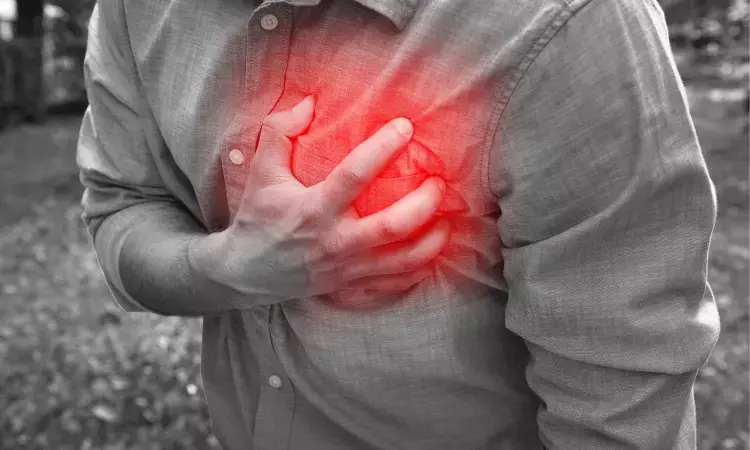- Home
- Medical news & Guidelines
- Anesthesiology
- Cardiology and CTVS
- Critical Care
- Dentistry
- Dermatology
- Diabetes and Endocrinology
- ENT
- Gastroenterology
- Medicine
- Nephrology
- Neurology
- Obstretics-Gynaecology
- Oncology
- Ophthalmology
- Orthopaedics
- Pediatrics-Neonatology
- Psychiatry
- Pulmonology
- Radiology
- Surgery
- Urology
- Laboratory Medicine
- Diet
- Nursing
- Paramedical
- Physiotherapy
- Health news
- Fact Check
- Bone Health Fact Check
- Brain Health Fact Check
- Cancer Related Fact Check
- Child Care Fact Check
- Dental and oral health fact check
- Diabetes and metabolic health fact check
- Diet and Nutrition Fact Check
- Eye and ENT Care Fact Check
- Fitness fact check
- Gut health fact check
- Heart health fact check
- Kidney health fact check
- Medical education fact check
- Men's health fact check
- Respiratory fact check
- Skin and hair care fact check
- Vaccine and Immunization fact check
- Women's health fact check
- AYUSH
- State News
- Andaman and Nicobar Islands
- Andhra Pradesh
- Arunachal Pradesh
- Assam
- Bihar
- Chandigarh
- Chattisgarh
- Dadra and Nagar Haveli
- Daman and Diu
- Delhi
- Goa
- Gujarat
- Haryana
- Himachal Pradesh
- Jammu & Kashmir
- Jharkhand
- Karnataka
- Kerala
- Ladakh
- Lakshadweep
- Madhya Pradesh
- Maharashtra
- Manipur
- Meghalaya
- Mizoram
- Nagaland
- Odisha
- Puducherry
- Punjab
- Rajasthan
- Sikkim
- Tamil Nadu
- Telangana
- Tripura
- Uttar Pradesh
- Uttrakhand
- West Bengal
- Medical Education
- Industry
Impaired cardiac metabolism linked to sudden cardiac death in future

Adults with abnormal heart metabolism are up to three times more likely to experience life-threatening arrhythmias (an irregular heart rhythm), and MRI techniques could be used to detect the condition and predict future sudden cardiac death (SCD), according to a small, but rigorous study led by Johns Hopkins Medicine researchers.
The findings were published June 22 in JCI Insight.
"We believe this is the first time that impaired cardiac metabolism in people has been linked to an increased risk of life-threatening arrhythmias or sudden cardiac death," says study senior author Robert Weiss, M.D., professor of medicine at the Johns Hopkins University School of Medicine. "This could open a window for a whole new approach, a metabolic approach for treating or preventing severe arrhythmias, which is something that is not currently available in cardiology."
Sudden cardiac death accounts for 50% of all cardiovascular deaths in the United States, claiming more than 300,000 American lives annually, according to the American Heart Association. Currently, an implantable cardioverter-defibrillator (ICD)-a small, battery-powered device placed in the chest to detect and stop irregular heart rhythms-is the primary means of preventing SCD in high-risk patients.
The device continuously monitors the heart rhythm and delivers electric shocks, when needed, to restore a regular heart rhythm. The battery life of an ICD is typically between five to seven years.
"Over seven years, 60%–70% of these devices never discharge to save a life," says T. Jake Samuel, Ph.D., first author of the study and fellow in cardiology at Johns Hopkins Medicine. "We're spending billions of dollars a year on ICDs that are implanted and have procedural and postprocedural risks. There is a need for noninvasive approaches to better assess risk for who needs or doesn't need an ICD to prevent sudden cardiac death in people."
For their study, Samuel and colleagues measured the levels of adenosine triphosphate (ATP), the primary chemical cellular energy source, in the hearts of 46 people prior to getting an ICD for primary prevention. The cardiac ATP levels were measured on clinical magnetic resonance imaging (MRI) scanners using a magnetic resonance spectroscopy (MRS) technique developed at Johns Hopkins Medicine bya co-author on the Paul Bottomley, Ph.D study, to determine which patients had abnormal ATP metabolism.
All patients were followed up every three to six months for an average of 10 years to determine which patients had appropriate ICD firings for life-threatening arrhythmias.
Results showed that people with low cardiac ATP levels (impaired metabolism) had a three-fold higher risk of sudden cardiac death (if not saved by ICD intervention) compared to those with normal ATP metabolism. This was still the case when adjusted for low left ventricular ejection fraction, the metric currently used to determine the need for a primary prevention ICD.
"The ICD was never needed in roughly 80% of those with normal cardiac ATP levels in the 10 years during the study period," Samuel and colleagues report. They say the study findings could complement current approaches and lead to better predictions for who's most likely to need, or not need an ICD. However, they stress, that more studies are needed to assess different and larger populations.
"But we're excited about these truly new findings, arguably the first in people, and believe they can be transformative on how doctors assess sudden cardiac death risk," Weiss says. "Once we have confirmed that metabolism and SCD are linked, we hope to study which drugs preserve and improve ATP metabolism, and whether they can be used to reduce SCD risk."
Reference:
T. Jake Samuel, Shenghan Lai, Michael Schär, Katherine C. Wu, Angela M. Steinberg, An-Chi Wei, Mark E. Anderson, Gordon F. Tomaselli, Gary Gerstenblith, Paul A. Bottomley, and Robert G. Weiss Published in Volume 7, Issue 12 on June 22, 2022 JCI Insight. 2022;7(12):e157557.
Dr Kamal Kant Kohli-MBBS, DTCD- a chest specialist with more than 30 years of practice and a flair for writing clinical articles, Dr Kamal Kant Kohli joined Medical Dialogues as a Chief Editor of Medical News. Besides writing articles, as an editor, he proofreads and verifies all the medical content published on Medical Dialogues including those coming from journals, studies,medical conferences,guidelines etc. Email: drkohli@medicaldialogues.in. Contact no. 011-43720751


